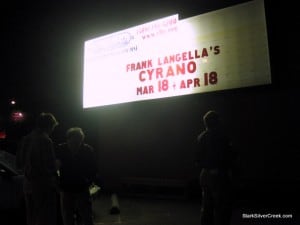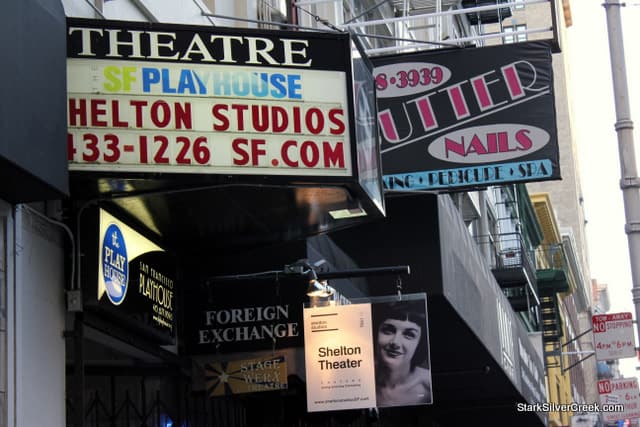
 Earlier this week I was invited to speak on a panel at the annual Theatre Bay Area conference. Entitled “Situation Critical: Theater Coverage in the New Media Landscape” and moderated by the gracious Karen McKevitt, who is also director of communications for Theatre Bay Area, five of us discussed new media, and in particular, its role and potential impact on the theater business.
Earlier this week I was invited to speak on a panel at the annual Theatre Bay Area conference. Entitled “Situation Critical: Theater Coverage in the New Media Landscape” and moderated by the gracious Karen McKevitt, who is also director of communications for Theatre Bay Area, five of us discussed new media, and in particular, its role and potential impact on the theater business.
The session lasted about an hour and took place at the gorgeous Herbst Theatre, a beautiful baby brother next to the equally stunning San Francisco War Memorial Opera House. This time, though, I wouldn’t be coming for a wine event or to see a symphony or opera. Instead we would explore some of the key challenges and questions facing the theater industry – and to some extent social and new media ideas applicable to others as well.
 We’ve been involved in theater at Stark Insider (formerly StarkSilverCreek) for just over a year now (the first show we covered was The Kite Runner at the San Jose Repertory Theatre in March 2009, a superb production), so for me at least, there would be equal opportunity to share our story and insights as an independent publisher, as there would be to learn, and to listen.
We’ve been involved in theater at Stark Insider (formerly StarkSilverCreek) for just over a year now (the first show we covered was The Kite Runner at the San Jose Repertory Theatre in March 2009, a superb production), so for me at least, there would be equal opportunity to share our story and insights as an independent publisher, as there would be to learn, and to listen.
Sitting on the stage, under the bright theater lights reminds me why I like to typically stay behind the scenes.

While I enjoy presenting, to be a relative new-comer, sitting amongst the people we respect who must earn a living and bring the passion day-in, day-out can be alternatively intimidating and inspiring. Normally I’d push Loni out front, under the spot, shout “Go!” and start filming, see what happens.
The business challenges in theater today are sobering. It’s a long list. Although others are in a better position to say, top of mind are: declining funding, price pressure, differentiating in a crowded marketplace for entertainment, attracting a next generation of theater-goer. And so forth, on and on. This does not even include the artistic side of the equation such as new play development, the relationship between playwrights and others, the Bay Area acting pool, etc.
I always recall what Rick Lombardo, artistic director at the SJ Rep, said once during an interview. To paraphrase, he lamented the fact that the government bailed out the banking industry, the auto industry… and, in some ways, I would even add the healthcare industry. But what about the arts?
What we do at Stark Insider (formerly StarkSilverCreek)
To understand my perspective, it’s important that at least you know where I’m going from. My perspective is not that of theater, obviously. I come from 17 years in marketing and tech. We’ve spent about three years now building a small network of media sites, social networks. There’s a long road ahead. It all started for us in a small fishing village on the crystal blue Sea of Cortez in a place called Loreto, but that is a story for another time.

Theater & arts coverage here includes reviews, previews/features, a what’s happening section and videos.
Where possible we try to bring something new to the table. For example, we’re engaged in Twitter and Facebook. And our videos allow us to connect with would-be theater-goers and hopefully (possibly we’re making home movies with nice music and edits?) convey that sense of electricity of a night out on the town. Because we cover other areas such as wine, travel, and food, the readers here can often be new-comers to theater. Stumbling upon a review, or article and then going to the show for the first time. Such conversions are rewarding for us.
We love every second of it, and Loni and I get satisfaction about being involved (however little) in theater and the arts. It activates the other side of the brain. The juices flow, baby. I suspect we share that much in common with many of those people at the conference this week. When the lights go down, the curtain drops… it’s that tingling moment. Oh, man, I love that moment. Anticipation. The excitement. Live theater!
Okay, too much already, onto the key themes discussed, at least as best as my memory and notes serve.
The Panel
Karen McKevitt (Theatre Bay Area) moderated. The other four panelists: Cheshire Isaacs (Impact Theatre), David Perry (David Perry & Associates), Eve Batey (SFAppeal.com) and Sam Hurwitt (TheIdiolect.com). I thought it was a good mix of media, PR and theater.
Karen also did a good job framing the topic, from the program: “With the traditional model of newspaper theatre criticism on the wane, what’s on the rise to fill the gap? Amid all the theatre blogs and audience reviews, is there a sustainable new model of theatre coverage developing? How are theatre companies to navigate the new media landscape?”
The Little Man
 Almost immediately discussion started with “the little man.” I had no idea what this meant at first. Naive me. But the Little Man is actually, well, a big man. Turns out I do know him. It refers to the iconic rating that famed theater critic Robert Hurwitt of the San Francisco Chronicle gives to a show. I’m not sure who created the image, but it is a stroke of genius. When given a strong review, the little man can be seen enthusiastically sitting on edge, clapping. If it’s exceptional, the bugger is almost falling out of his seat, cheering with a happy meal grin. I’ve never seen it, but I’ve heard a bad show can put the little man to sleep. See, the little man does make people talk.
Almost immediately discussion started with “the little man.” I had no idea what this meant at first. Naive me. But the Little Man is actually, well, a big man. Turns out I do know him. It refers to the iconic rating that famed theater critic Robert Hurwitt of the San Francisco Chronicle gives to a show. I’m not sure who created the image, but it is a stroke of genius. When given a strong review, the little man can be seen enthusiastically sitting on edge, clapping. If it’s exceptional, the bugger is almost falling out of his seat, cheering with a happy meal grin. I’ve never seen it, but I’ve heard a bad show can put the little man to sleep. See, the little man does make people talk.
Of course, it’s really not just about the graphic.
 It’s about the influence of a traditional newspaper on theater sales. That a positive review comes from a veteran like Robert Hurwitt rightfully brings instant credibility.
It’s about the influence of a traditional newspaper on theater sales. That a positive review comes from a veteran like Robert Hurwitt rightfully brings instant credibility.
So, theaters want that little man. Even if he’s not necessarily ecstatic. The tiny theaters (< 99 seats) want to know how to get coverage. A write up in the Chronicle can lead to sales.
However, times are changing. Big time. And so is our controversial Little Man.
First, you need to separate the critics (Robert Hurwitt, and also the equally well-regarded Karen D’Souza of the San Jose Mercury News) from the channel of distribution that is used to reach readers. Professional critics will always have their place (check out Avatar on IMDB… why, praytel, does a mega-blockbuster need over 300 reviews? I doesn’t, but people like to read opinion and discuss). Experience, strong writing ability, good story-telling, intelligent critique are all qualities that should continue to be respected, and developed.
But, like most print publications, the circulation of the Chronicle is a disaster. If the Little Man reached half a million subscribers before, he now only reaches half that. You can’t write your way out of the crush, it’s an economic sign of the times. Keep in mind, however, SFGate, their online property, continues to grow and by some accounts is the fifth largest online newspaper property.
Worse, it’s unlikely the Little Man is even reaching the hundreds of thousands (millions?) of people that live in the Bay Area that instead get their daily dose from the media uber trifecta: Facebook, Twitter, Google News. I’m not suggesting this is right, or even the way it will be. But it’s the way it is today.
The reckoning of new media: now it’s Little Men and Women.
Gap in Coverage?

There was not agreement on the panel that a gap even exists between traditional newspaper coverage and that of new media. It’s an interesting discussion point.
Sam pointed out that theater and arts coverage is in a general state of woeful decline (my words). A massive funk I guess you could call it. I would add that part of this has to do with our hyper-nano-second-driven culture of instant 140-character gratification. That quality of thought, analysis and debate are losing out to emoticons, LOL, and 3-D.
Eve disagreed and suggested that a quick Google search for any given play can reveal many sources of reviews and information. Any gap has been replaced by scores of bloggers, tweeters, Facebookers, etc.
The Canadian in me says there’s probably partial truth in both arguments.
True, theater criticism is on the decline, but only in traditional media (newspaper, tv, radio).
And yes, more blogs are emerging that write about theater.
The issue, however, may be sustainability and business models. After all, it’s one thing to read about your friend’s sister’s Aunt’s experience at Slasher at SF Playhouse. But it’s another thing entirely to come back the following week and discover her writing about diapers.
Leveraging Social Media

By Social Media I mean Facebook and Twitter. Almost everything else (with the possible exception of YouTube) is second tier. And when I refer to New Media I mean publishers, Bloggers, community-driven news, etc. which I’ll get to in a moment. The two together, however, comprise a powerful tool-set that is and can change the game; effectively removing the middle man (but never the Little Man!) in creating engagement with a theater’s customer base.
The obvious: Every theater, large and small, needs a Facebook page and a Twitter account. YouTube is a consideration too. It brings in views. Every venue in our SSC Theater Guide has these already. This is the easy part.
The hard part: what next?
A few considerations.

It takes time. Don’t expect hundreds of fans (or likes) right away. It might take years. In fact, the process never ends. These #’s are in some ways akin to circulation.
Don’t compete on price. It can harm your brand. Understandably you may need to if your target audience is seniors or students. But even then, always demonstrate value first. Heavy discounting is the worst form of marketing. Instead, create compelling messages. Contests. Social media events.
Create conversation and engagement. Don’t spam. Social media is two-way. This is the beauty (or scourge depending on your mindset). That means you’ll need to have someone responsible for creating living, breathing, meaningful conversation; not just blasting promotions.
Be transparent. Be real. The social Internet has a way of sniffing out the phonies or the BS-factor. I recall someone commenting negatively on a show at American Conservatory Theater. I forgot which one, possibly November. Instead of hiding, ACT responded to the person on Facebook. Carey Perloff, the artistic director, wrote something to the effect that this (disagreement) was one of the great things about theater, everyone has an opinion. I know some large Broadway-based houses that do the opposite: Squashing open thought, even possibly deleting comments. Unless it’s hateful or laced with profanity, it should be in the open.
Working with New Media, Blogs

The panel discussed many ideas when it came to how theater companies can reach out and work with new media.
Ironically, we as “New Media” face many of the same challenges as the theater industry. Business models are typically built around traffic, readership, viewers. This leads to advertising sales. But budgets are tight, and competition is fierce. Part of this has to do with the low barriers to entry: Anyone can start a blog and write about whatever they fancy. Of course, just like theaters, all Blogs and Web sites are not created equal.
Which leads me to my first point. As a theater house, know who you’re dealing with if you decide to engage with a Blog or Web Site that has a limited track record. I would want to know the people behind the organization, their values, the types of articles they write, and their ultimate goals. Numbers alone don’t tell the whole story, although they can certainly help. For all you know, that follower might just be a clever cat with a decent Internet connection.
If Twitter Followers were the absolute measure, than all of you better start calling Ashton Kutcher or Lady GaGa.
Of course, that might be fun, but it would be absurd. The Internet is a marketer’s dream. We can now finely segment markets. Want to target 18-35 years old within a 5-mile radius of San Mateo? You can do that. Have a corporate theater promotion in mind and want to extend the offer to only employees of Google, Apple and Adobe? Yes, you can do that to. It’s segmentation paradise.
This means every marketing dollar in, has a higher probability of filling a seat in your theater, or getting someone to click-through to learn more.
A publisher should be able to tell a theater marketing department who they reach. Not just a number, but also demographics such as age, income, education. Maybe you want to reach people who drink water. Well, that’s a large group. That’s okay. Or maybe you need to reach people who own a yacht, a private jet and a Luxor-like burial tombstone. That would be a very small group. Both are valid, it just depends on the offer and your theater’s target audience. More likely, your goal is somewhere in between the two extremes.
Key Takeaways
There are no clear answers yet. Still.
I have yet to see a new model emerge.
However, savvy and deep-pocketed traditional media companies such as Wall Street Journal, New York Times are all-over the Apple iPad. Will it work? It’s hard to say. I think it will partially. But there’s a new generation groomed to get stuff free. Aka, the freemium generation.
It’s going to be an interactive world of Ads. I don’t see any other way to support publishing long-term. Sure, there is the non-profit, community-driven approach. PBS has been around for ages. Niche examples of that approach on the web may emerge.
For theaters, new media opens a world of possibility. You can control the game more than ever before, relying less on the Little Man as your sole way to drive ticket sales. As independent publishers, we face many of the same challenges.
Reach out and try new things (for a fresh example, check out SF Playhouse and the live Tweets during last night’s performance of Slasher – it’s like the theater equivalent of a wine tasting “TweetUp”). Partner. Treat it as a long-term investment, not just in money, but in time and relationships as well. You may be surprised by the results.



